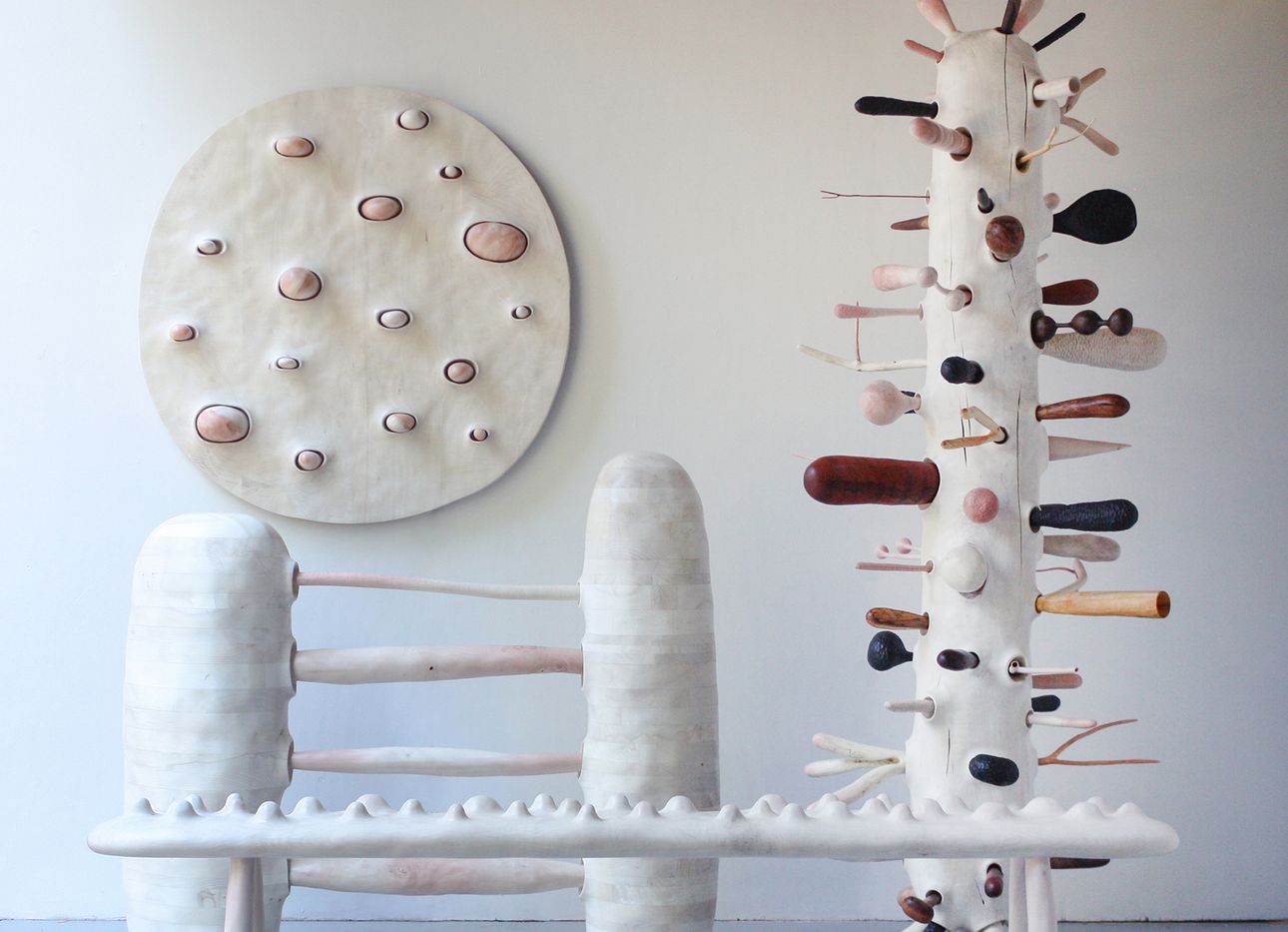
Julian Watts Heeds the Call of the Wild
Julian Watts likes to collect sticks. The artist has a barn full of them, and spends a lot of time searching for new ones on the five-acre property in Alpine, Oregon, where he lives with his partner, three cats, and dog. Sometimes, he’ll carry twigs around with him as he explores the area, which includes a wooden house (“It used to be a creepy hippie tower,” Watts says) and a workshop on top of a hill that opens onto a flower-filled meadow, a vegetable garden, and a bog hemmed in by ash trees. Some of the sticks become the medium for his mystical works, which he chisels and sands by hand into blobby forms that are at once gorgeous and grotesque.
Watts’s move from Oakland, California, to rural Oregon, in 2018, hinted at his Thoreau-like desire for simple living in natural surroundings. The pandemic amplified that longing, leading him to define ‘home” in a different way—extending the margins of the idea from his house into the landscape and the ecosystems around it. This newfound connection to nature has filtered into Watts’s most recent work, created in lockdown during the pandemic, where freakish objects made from wood and alabaster ripple with life and increased fervor, daring you to touch them. They’re all part of “Homelife,” his second solo exhibition at New York’s Patrick Parrish Gallery, on view through Oct. 16. We recently caught up with Watts to discuss how the natural world impacts his work and what he looks for in a good stick.
I imagine the remoteness of your home lends itself to deep introspection. What have you been thinking about lately?
To be honest, I’ve been appreciating what we have by thinking about it less. Every day I try to walk around for at least an hour, or just sit under a tree and try to take advantage of this weird time. I had a hermit lifestyle before the pandemic. So now, I’m focusing on taking in the environment on a deeper level. I’ve been reading a lot of old mystical Zen poetry by people like Stonehouse—he was a Chinese monk whose writing is all about spending time in space in a way that’s really low, down inside your core, and not overthinking things.
Has your heightened connection with your surroundings changed what you look for in a stick?
A lot of it has to do with touch. In collecting sticks and flowers and leaves, it’s not just about visual references. I’m accumulating ideas and research through them, too. I’ll spend a lot of time just carrying sticks around and touching them. It’s a huge part of my design process.
I also think about the material’s relationship with the viewer. While looking at one of my pieces, there’s always a conflicting sense of being repulsed by it and an urge to touch it. That experience is almost as important as the visual aspect of my work.
Can people touch the pieces you exhibit?
Whether they end up touching it or not, they’re probably thinking about it.
Where do the weird shapes in your work come from?
Pinpointing the source of the weirdness—that’s what it’s all about. I think it comes from some of the things we were talking about earlier: giving myself time and space, in a really intentional way, to let my mind wander and make connections. A lot of the weirdness comes from nature. My work often weaves in references to the cosmic, like the moon or the night sky. It also has these really visceral references to the human body on an uncomfortable level. I want to trigger people to think about things in different ways. That’s why a lot of my work looks like a warped bodily form. So they’ll think, Okay, what does this make me feel, and where else can I see these shapes? How do they reference a larger natural process?
Tell me about the role tactility plays in carving an object.
It’s a push-and-pull type of thing. I almost never just start carving a piece of wood and see where it goes. There’s always a plan. It begins with letting my mind go. Then, I’ll do a mock drawing. I take out my sketchbooks and make little drawings—not technical or anything, just cartoon-y scribbles, weird irregular things. I carve from those, trying to capture the hand-drawn quality in the work. As I carve, shape, and remove wood, it starts to guide me.
I can see your hand in every piece you create.
My work is an intensely hands-on thing. I touch every single surface so many times. You get to know the different shapes that way. Machines create simple, flat curves. Sometimes I use power tools to rough things up, but I always finish them with a hand-sanded or hand-carved texture. You can see a lot of that in the pieces in the show. There are little divots and bumps—a surface quality that’s created by hand. That’s an important connection to have. It gives everything a real human energy.